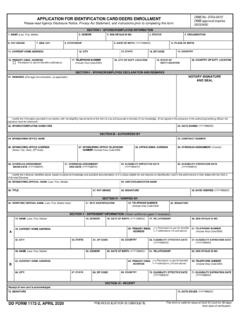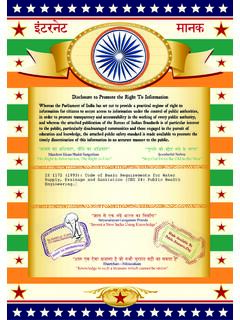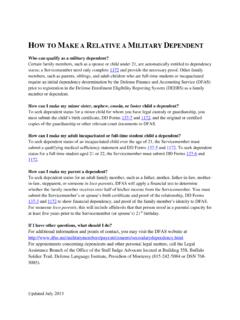Transcription of Distinguishing between a Democracy and a Republic
1 Distinguishing between a Democracy and a Republic The United States is not a Democracy , and the Founders used strong words to make clear that their nation should never become one. Consider the following statements: Benjamin Rush: A simple Democracy .. is one of the greatest of evils (1789). James Madison: Democracies have ever been spectacles of turbulence and contention; have ever been found incompatible with personal security, or the rights of property; and have, in general, been as short in their lives as they have been violent in their deaths (1787).
2 John Adams: Remember, Democracy never lasts long. It soon wastes, exhausts, and murders itself. There never was a Democracy yet that did not commit suicide (1814). Thomas Jefferson: "An elective despotism was not the government we fought " (1782) Edmund Randolph: "..that in tracing these evils to their origin every man had found it in the turbulence and follies of Democracy . (1787) John Marshall: " between a balanced Republic and a Democracy , the difference is like that between order and chaos." The simple fact is that the United States is a Republic (and a constitutional Republic at that), not a Democracy , by purposeful design.
3 D E M O C R A C Y The chief characteristic and Distinguishing feature of a Democracy is: rule by majority. People meet and exercise government in person, which can be done in a small territorial area. In a Democracy , the individual, and any group of individuals composing any minority, have no protection against the unlimited power of the majority. This is true whether it be a direct or a representative Democracy . In the direct type, all of the electorate assemble to debate and decide all government questions, and majority vote rules. In a representative Democracy , people elect representatives to the national legislature who in turn make all legislative decisions.
4 In both the direct and the representative type of Democracy , the majority s power is absolute and unlimited; its decisions are unappealable under the legal system established to give effect to this form of government. This opens the door to concerns. This was what the Framers expressed when they condemned the "excesses of Democracy " or tyranny of the majority , and abuses under any Democracy of the unalienable rights of the individual by the majority. Examples were provided in the immediate post-1776 years by the legislatures of some of the States. In reaction against earlier royal tyranny, which had been exercised through oppressions by royal governors and judges of the new State governments while the legislatures acted as if they were virtually omnipotent.
5 There were no effective State Constitutions to limit the legislatures. This topic of the dangers to the people s liberties due to the turbulence of democracies and omnipotent, legislative majority is discussed in Federalist Papers 10 and 48. The Framers, by their protests against the "excesses of Democracy ," were merely making clear their sound reasons for preferring a Republic as the proper form of government. In a Democracy , people hold the power to rule directly. Examples of Democracy in action in this country include initiative and referendum, where the people vote directly on specific issues.
6 Naturally, it would be impractical to administer an entire country if people had to have a direct vote on every issue. The word Democracy does not appear in the Constitution or the Declaration of Independence. R E P U B L I C Republicanism stresses liberty and inalienable rights as central values, makes the people as a whole sovereign, rejects inherited political power, expects citizens to be independent in their performance of civic duties, and vilifies corruption. Most significant difference from Democracy ; Republicanism asserts that people have unalienable rights that cannot be voted away by a majority of voters; it is rule rooted in laws.
7 A Republic implicitly contains the element that we would call Democracy , but it is understood that the US is a representative Democracy , in which the people choose representatives who in turn decide the issues of the day in competition with other branches of the government and in accordance with the law. Governance, in other words, has a basis in the people but is removed from the mob. The purpose of a Republic is to control the majority. Representatives are chosen and they meet to exercise government; this can be done over a wider territory. So one might say that the Republic lengthens the distance between the decision and the mob, relative to a Democracy .
8 (By contrast, in a dictatorship, there is no distance at all: the mob is completely cut out from the decision) Federalist Paper (James Madison) "As there is a degree of depravity in mankind which requires a certain degree of circumspection and distrust: So there are other qualities in human nature, which justify a certain portion of esteem and confidence. Republican government (that of a Republic ) presupposes the existence of these qualities in a higher degree than any other form . Were the pictures which have been drawn by the political jealousy of some among us, faithful likenesses of the human character, the inference would be that there is not sufficient virtue among men for self government; and that nothing less than the chains of despotism can restrain them from destroying and devouring one another.
9 " Federalist Papers (James Madison) The two great points of difference between a Democracy and a Republic are: first, the delegation of the government, in the latter, to a small number of citizens elected by the rest; secondly, the greater number of citizens, and greater sphere of country, over which the latter may be extended LECTURE NOTES INTRODUCTION In recognition that it's Congress that poses the greatest threat to our liberties, the framers used negative phrases against Congress throughout the Constitution such as: shall not abridge, infringe, deny, disparage, and shall not be violated, nor be denied.
10 In a republican form of government, there is rule of law. All citizens, including government officials, are accountable to the same laws. Government power is limited and decentralized through a system of checks and balances. Government intervenes in civil society to protect its citizens against force and fraud but does not intervene in the cases of peaceable, voluntary exchange. Contrast the framers' vision of a Republic with that of a Democracy . In a Democracy , the majority rules either directly or through its elected representatives. As in a monarchy, the law is whatever the government determines it to be.








